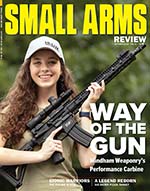Book Reviews: V22N8
By Dean Roxby
The French Needle-Ignition Rifle
Well Researched and Illustrated Book Lacking Some Details
The French Chassepot (pronounced “Shawss-poe”) rifle is an interesting step in the evolution of small arms development. It is a needle-fire system, similar to the earlier German Dreyse needle-fire, but with several improvements.
Both the Dreyse and the Chassepot systems were from the transitional period when armies were moving away from using muzzle-loaders and going to breech-loading arms. Both used a one-piece, self-contained cartridge made from paper and contained an internal primer cap. Rather than a modern day firing pin to ignite the primer, these systems used a long, thin, sharpened needle-like pin to pierce into the round to reach the primer, hence the name.
In 1870, the two needle-fire rifles, Dreyse and Chassepot, faced off in battle during the Franco-Prussian war. The general consensus was that the French rifle was superior to the German/Prussian design, but superior battle tactics and longer range artillery helped the Prussian army to overwhelm French forces.
The Chassepot rifle was better in several ways. As both breech-loaders used paper cartridges, not brass cases, sealing the breech against gas leakage was a serious issue. The Chassepot used a rubber gasket in the bolt to deform under pressure to effectively seal the breech. This prevented the shooter from getting a face full of hot gasses. The needle was also less prone to breakage and easier to replace if it did break. Finally, the Chassepot had far better ballistics.
The A-R-West brothers (Alston-Roberts-West) are well known as antique arms collectors in Great Britain and beyond. They are also active on gun forums such as GunBoards.com. This book features many of their own firearms, as well as samples from other collections.
Beginning with a brief look at several other trials of rifles tested by France during the mid- to late 1850s, as well as earlier versions of the Chassepot system, the book then studies the 1866 model, the version adopted for military service. The role the rifle played in the Franco-Prussian war is also examined.
This book does a fine job of illustrating the receiver markings and other details of different versions. Receiver markings and proof and acceptance marks from the four French arsenals (Châtellerault, Mutzig, Saint-Etienne and Tulle), as well as foreign-made versions, are covered in detail. Markings found on the stock are also studied. Bayonet and scabbard markings are covered as well.
Component parts such as the bolt assembly and the rear sight ladder are shown in close-up detail. The bolt is shown disassembled into its individual parts.
While these are often shown in color photographs, as expected, many are clear, crisp artist’s illustrations. This allows specific details to be brought out. As well, some 1860s-era engraving type pictures are shown. As interesting as they are, these are nearly impossible to read as shown. I would have liked to see the original displayed along side an enlarged and cleaned-up reproduction.
Various accessories are covered in detail. Things like small spare parts kits, cleaning rods and bore jags, fowling scrapers, oil bottles and even a tompion, or wooden muzzle plug are shown. Naturally, bayonets, scabbards, scabbard frogs and rifle slings are illustrated in detail. Several types of cartridges and cartridge boxes are shown. The authors have gone so far as to make up accurate reproduction nine-round cardboard ammo boxes, complete with arsenal markings. (I would have liked to see dimensions included, so that I could do the same for my rifle!)
A brief mention of the Gras conversion to brass centrefire cartridges is given towards the end.
One thing that is not covered is information on handloading your own ammo. There is some info to be found on the Internet (enough for me to get mine firing again), but I was hoping for some detailed instructions gleaned from the authors’ several decades of collecting and firing needle guns. Not a deal breaker, but worth noting.
Even without handloading info, there is a great deal of information about an intriguing rifle in this book. If you own a Chassepot, or are thinking of buying one, you should certainly consider this book.
The Needle-Ignition System of The Modèle 1866 “Chassepot”, An Illustrated History
AUTHORS: Guy and Leonard A-R-West
PUBLISHER: Woodfield Publishing Ltd, woodfieldpublishing.co.uk
ISBN: 978-1-84683-187-4
COPYRIGHT: 2017
PAGES: Soft cover, 8” x 11.5” full color throughout, 146 pages
PURCHASE: Available from Woodfield Publishing or its Amazon UK store.
CORRECTION
We regret that we included Steven J. Zaloga as the author of the Lyman Long Range Precision Rifle Reloading Handbook in SAR, Vol. 22, No. 7. Steven J. Zaloga is not the author of this handbook; there is no listed author for this handbook.
This article first appeared in Small Arms Review V22N8 (October 2018) |
| SUBSCRIBER COMMENT AREA |
Comments have not been generated for this article.




